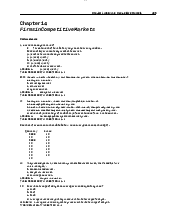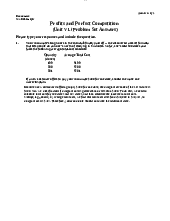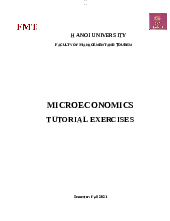



















Preview text:
lOMoARcPSD|46342985 lOMoARcPSD|46342985
Chapter 6/Supply, Demand, and Government Policies 159 Chapter6
Supply,Demand,andGovernmentPolicies MULTIPLECHOICE Pricecontrolsare
a.usedtomakemarketsmoree cient. ffi
b.usualyenactedwhenpolicymakersbelievethatthemarketpriceofagoodorserviceisunfairtobuyersor selers.
c.nearlyalwayse ectiveinelminatinginequities. ff
d.establishedbyfirmswithmonopolypower. ANSWER:b.
usualyenactedwhenpolicymakersbelievethatthemarketpriceofagoodorserviceisunfairtobuyers orselers. TYPE:MDIFFICULTY:2 23
Policymakerschoosetoenactpricecontrolsinamarketbecause
a.theybelievethemarket’soutcometobeunfair.
b.enactingpricecontrolswildirectlyincreasetaxrevenues.
c.theyarerequiredbylaw toimprovemarketconditions.
d.theybelievethathemarketsystem isine cientandtheiractionswilimprovee ffi ciency. ffi ANSWER:a.
theybelievethemarket’soutcometobeunfair. TYPE:MSECTION:1DIFFICULTY:2 23
Policymakersareledtocontrolpricesbecause
a.theyview themarket’soutcomeasine cient. ffi
b.theyview themarket’soutcomeasunfair.
c.alpoliticiansenjoyexercisingtheirpower.
d.theyarerequiredtodosoundertheEmploymentActof1946. ANSWER:b.
theyview themarket’soutcomeasunfair. TYPE:MSECTION:1DIFFICULTY:2 23 Pricecontrols
a.alwaysproduceanequitableoutcome.
b.alwaysproduceane cientoutcome. ffi
23 cangenerateinequitiesoftheirown.
d.producerevenueforthegovernment. ANSWER:c.
cangenerateinequitiesoftheirown. TYPE:MSECTION:1DIFFICULTY:2 23
Whichofthefolowingisareasonpolicymakersimposetaxes?
a.toatempttomakemarketsmoree cient ffi b.toinfluencemarkeoutcomes c.toraiserevenueforpublicuse d.Aloftheabovearecorrect. e.Bothbandcarecorrect. ANSWER:e.Bothbandcarecorrect. TYPE:MSECTION:1DIFFICULTY:2 23
A legalmaximum priceatwhichagoodcanbesoldisaprice a.floor. b.stabilization. 23 support. d.ceiling. ANSWER:d. ceiling. TYPE:MSECTION:1DIFFICULTY:1 lOMoARcPSD|46342985
Chapter 6/Supply, Demand, and Government Policies 160 23 A government-imposedmaximum
priceatwhichagoodcanbesoldiscaledaprice a.floor. b.ceiling. c.support. d.equilibrium. ANSWER:b. ceiling. TYPE:MSECTION:1DIFFICULTY:1 23 A priceceiling
a.isalegalmaximum onthepriceatwhichagoodcanbesold.
b.isalegalminimum onthepriceatwhichagoodcanbesold.
23 occurswhenthepriceinthemarketistemporarilyaboveequilibrium.
d.wilusualyresultinamarketsurplus. ANSWER:a.
isalegalmaximum onthepriceatwhichagoodcanbesold. TYPE:MSECTION:1DIFFICULTY:1 23
A legalminimum priceatwhichagoodcanbesoldisaprice a.cut. b.stabilization. 23 ceiling. d.floor. ANSWER:d. floor. TYPE:MSECTION:1DIFFICULTY:1 23 A pricefloor
a.isalegalminimum onthepriceatwhichagoodcanbesold.
b.isalegalmaximum onthepriceatwhichagoodcanbesold.
23 wilgeneralyresultinamarketshortage.
d.wilbenefittheconsumer,buthurtthesupplier. ANSWER:a.
isalegalminimum onthepriceatwhichagoodcanbesold. TYPE:MSECTION:1DIFFICULTY:1 23
A priceceilingwilonlybebindingifitisset a.equaltoequilibrium price. b.aboveequilibrium price. c.below equilibrium price.
d.A priceceilingisneverbindinginafreemarketsystem. ANSWER:c. below equilibrium price. TYPE:MSECTION:1DIFFICULTY:2 23 A bindingpriceceilingcauses
a.ashortage,whichcannotbeelminatedthroughmarketadjustment.
b.asurplus,whichcannotbeelminatedthroughmarketadjustment.
c.ashortage,whichistemporary,sincemarketadjustmentwilcausepricetorise.
d.asurplus,whichistemporary,sincemarketadjustmentwilcausepricetorise. ANSWER:a.
ashortage,whichcannotbeelminatedthroughmarketadjustment. TYPE:MSECTION:1DIFFICULTY:2 23 Ifapriceceilingisnotbinding,
a.theequilibrium priceisabovetheceiling.
b.theequilibrium priceisbelow theceiling.
23 ithasnolegalenforcementmechanism.
d.peoplemustvoluntarilyagreetoabidebyit. ANSWER:b.
theequilibrium priceisbelow theceiling. TYPE:MSECTION:1DIFFICULTY:2 23
A priceceilingthatisnotbindingwil a.causeasurplusinthemarket. b.causeashortageinthemarket.
c.causethemarkettobelesse cient. ffi d.havenoe ectonthemarketprice. ff ANSWER:d. havenoe ectonthemarketprice. ff TYPE:MSECTION:1DIFFICULTY:2 lOMoARcPSD|46342985
Chapter 6/Supply, Demand, and Government Policies 161 23
Bindingpriceceilingsinamarketcausequantitydemandedtobe
a.greaterthanquantitysupplied. b.equaltoquantitysupplied. c.lessthanquantitysupplied. d.Anyoftheabovearepossible. ANSWER:a. greaterthanquantitysupplied. TYPE:MSECTION:1DIFFICULTY:3 23
Ifabindingpriceceilingisimposedinamarket
a.therewilbeasurplusinthemarket.
b.thepricewilbelegalyforcedtowardequilibrium price.
23 therewilbeashortageinthemarket.
d.marketforceswilguaranteethatthepricewilbeatequilibrium. ANSWER:c.
therewilbeashortageinthemarket. TYPE:MSECTION:1DIFFICULTY:2 23
Inthefigureshown,abindingpriceceilingisshownin a.panel(a). b.panel(b). 23 bothpanel(a)andpanel(b). d.neitherpanel(a)norpanel(b). ANSWER:b. panel(b). TYPE:MSECTION:1DIFFICULTY:2 23
Inwhichpanel(s)inthefigureshownwouldtherebea
shortageforCDsattheceilingprice? a.panel(a) b.panel(b) 23 panel(a)andpanel(b) d.neitherpanel(a)norpanel(b) ANSWER:b. panel(b) TYPE:MSECTION:1DIFFICULTY:2 23
Accordingtothegraphshown,abindingpriceceiling wouldexistatapriceof a.$14.00. b.$12.00. 23 $10.00. d.$8.00. ANSWER:d. $8.00. TYPE:MSECTION:1DIFFICULTY:2 lOMoARcPSD|46342985
Chapter 6/Supply, Demand, and Government Policies 162 23
Accordingtothegraphshown,ifthegovernmentimposesabindingpricefloorof$14.00inthismarket,theresult wouldbea a.surplusof20. b.surplusof40. c.shortageof20. d.shortageof40. ANSWER:b. surplusof40. TYPE:MSECTION:1DIFFICULTY:3 23
Accordingtothegraphshown,ifthegovernmentimposesabindingpriceceilingof$8.00inthismarket,theresult wouldbea a.surplusof20. b.surplusof40. 23 shortageof20. d.shortageof40. ANSWER:c. shortageof20. TYPE:MSECTION:1DIFFICULTY:3 23
Accordingtothegraph,abindingpricefloorwouldexistat a.apriceof$10.00. b.apriceof$8.00. 23 anypriceabove$10.00. d.anypricebelow $10.00. ANSWER:c. anypriceabove$10.00. TYPE:MSECTION:1DIFFICULTY:3 23 A pricefloorisbindingifitis
a.higherthantheequilibrium marketprice.
b.lowerthantheequilibrium marketprice.
c.equaltotheequilibrium marketprice. d.setbythegovernment. ANSWER:a.
higherthantheequilibrium marketprice. TYPE:MSECTION:1DIFFICULTY:2
24. Withabindingpricefloorthemarketpricewil a.belowerthanthepricefloor. b.behigherthanthepricefloor. c.equalthepricefloor.
d.Itisimpossibletocomparethemarketpricewiththepricefloor. ANSWER:a. belowerthanthepricefloor. TYPE:MSECTION:1DIFFICULTY:2 23
A bindingpricefloorinamarketsetsprice
a.aboveequilibrium priceandcausesashortage.
b.aboveequilibrium priceandcausesasurplus.
23 below equilibrium priceandcausesasurplus.
d.below equilibrium priceandcausesashortage. ANSWER:b.
aboveequilibrium priceandcausesasurplus. TYPE:MSECTION:1DIFFICULTY:3 A pricefloorisnotbindingif
a.thepricefloorishigherthantheequilibrium marketprice.
b.thepricefloorislowerthantheequilibrium marketprice.
c.peoplearewilingtobuylesswhenthepricefloorisimposedastheydibefore. d.thegovernmentsetsit. ANSWER:b.
thepricefloorislowerthantheequilibrium marketprice. TYPE:MSECTION:1DIFFICULTY:2 lOMoARcPSD|46342985
Chapter 6/Supply, Demand, and Government Policies 163 A bindingpricefloorcauses a.excessdemand. b.ashortage. c.asurplus. d.equilibrium pricetofal. ANSWER:c. asurplus. TYPE:MSECTION:1DIFFICULTY:2
Inthefigureshown,whichofthepanelsrepresentsabindingpricefloor? a.panel(a) b.panel(b) panel(a)andpanel(b) d.neitherpanel(a)norpanel(b) ANSWER:b. panel(b) TYPE:MSECTION:1DIFFICULTY:2
29. Inpanel(b),atheactualpricetherewilbe a.ashortageofwheat. b.equilibrium inthemarket. c.asurplusofwheat. d.anexcessdemandforwheat. ANSWER:c. asurplusofwheat. TYPE:MSECTION:1DIFFICULTY:2
Ifapriceceilingisabindingconstraintonthemarket,
a.theequilibrium pricemustbebelow thepriceceiling.
b.theequilibrium pricemustbeabovethepriceceiling.
theforcesofsupplyanddemandmustbeinequilibrium.
d.itwilhavenoe ectonsupplyordemand. ff ANSWER:b.
theequilibrium pricemustbeabovethepriceceiling. TYPE:MSECTION:1DIFFICULTY:2
Ifapriceceilingisabindingconstraint,the
a.actualpricewilbebelow thepriceceiling.
b.actualpricewilbeabovethepriceceiling.
c.equilibrium pricewilequalthepriceceiling.
d.actualpricewilequalthepriceceiling. ANSWER:d.
actualpricewilequalthepriceceiling. TYPE:MSECTION:1DIFFICULTY:3 lOMoARcPSD|46342985
Chapter 6/Supply, Demand, and Government Policies 164
Whenbindingpriceceilingsareimposedinamarket
a.pricenolongerservesasaratoningdevice.
b.themarketwilbeclearedofanyshortagesorsurplusesthatexistedpreviously.
c.buyersandselersbothbenefitequaly.
d.thegovernmentisattemptingtoimprovemarkete ciency. ffi ANSWER:a.
pricenolongerservesasaratoningdevice. TYPE:MSECTION:1DIFFICULTY:3
Whenbindingpriceceilingsareimposedtobenefitbuyers
a.everybuyerinthemarketbenefitsbecauseoflowerprices.
b.somebuyerswilnotbeabletobuyanyoftheproduct.
selersinthemarketwilequalybenefitfrom apriceceiling.
d.thequantityselerswanttoselwilequalthequantitybuyerswanttobuy. ANSWER:b.
somebuyerswilnotbeabletobuyanyoftheproduct. TYPE:MSECTION:1DIFFICULTY:2
34. A bindingpriceceilingisimposedonthemarketforpeaches.Attheceilingprice,thequantitydemandedofpeaches wilbe
a.greaterthanthequantitysupplied. b.equaltothequantitysupplied.
smalerthanthequantitysupplied.
d.artificialyrestrictedbythepriceceiling. ANSWER:a.
greaterthanthequantitysupplied. TYPE:MSECTION:1DIFFICULTY:3
A bindingpriceceilinginthecomputermarketwilcause
a.asurplusofcomputers. b.ashortageofcomputers.
c.quantitydemandedofcomputerstobeequaltoquantity supplied.
d.anincreaseinthedemandforcomputers. ANSWER:b. ashortageofcomputers. TYPE:MSECTION:1DIFFICULTY:2
A bindingpriceceilingwilmakeitnecessaryto a.supplymoreoftheproduct.
b.developawayofratoningtheproduct,becausetherewilbea shortage.
developabetermarketingplan,becausetherewilbea surplus. d.increasedemandfortheproduct. ANSWER:b.
developawayofratoningtheproduct,becausethere wilbeashortage. TYPE:MSECTION:1DIFFICULTY:3
BindingpriceceilingsresultineachofthefolowingEXCEPT a.marketine ciency. ffi b.shortages. c.selerbias. d.surpluses. ANSWER:d. surpluses. TYPE:MSECTION:1DIFFICULTY:2
Accordingtothegraphshown,ifthegovernmentimposesabindingpriceceilinginthismarketatapriceof$5.00, theresultwouldbea a.shortageof20units. b.shortageof10units. surplusof20units. d.surplusof10units. ANSWER:a. shortageof20units. TYPE:MSECTION:1DIFFICULTY:2 lOMoARcPSD|46342985
Chapter 6/Supply, Demand, and Government Policies 165
Accordingtothegraphshown,abindingpriceceilingwouldexistatapriceof a. $8.00. b.$6.00. c.$5.00.
d.Itcouldexistatanypriceabove$6.00. ANSWER:c. $5.00. TYPE:MSECTION:1DIFFICULTY:2
Accordingtothegraphshown,ifthegovernmentimposesabindingpricefloorof$5.00inthismarket,theresult wouldbea a.surplusof15. b.surplusof35. surplusof20. d.shortageof20. ANSWER:b. surplusof35. TYPE:MSECTION:1DIFFICULTY:2
Accordingtothegraphshown,abindingpricefloorwouldexistatapriceof a. $5.00. b.$4.00. c.$2.00.
d.Itcouldexistatanypricebelow $4.00. ANSWER:a. $5.00. TYPE:MSECTION:1DIFFICULTY:2 Ratoningbylonglinesis
a.ine cient,becauseitwastesbuyers’time. ffi
b.e cient,becausethosewhoarewilingtowaithelongestgetthegoods. ffi
theonlywayscarcegoodscanberationed.
d.onlynecessaryifpriceceilingsarenotbinding. ANSWER:a.
ine cient,becauseitwastesbuyers’time. ffi TYPE:MSECTION:1DIFFICULTY:1 Priceceilingsandpricefloors
a.aredesirablebecausetheymakemarketsmoree cientaswelasequitable. ffi
b.causesurplusesandshortagestopersistsincepricecannotadjusttothemarketequilibrium price.
c.canbeenactedtorestoreamarkettoequilibrium.
d.areimposedbecausetheycanmakethepoorintheeconomybettero wihoutcausingadversee ff ects. ff
ANSWER:b. causesurplusesandshortagestopersistsincepricecannotadjusttothemarketequilibrium
price. TYPE:MSECTION:1DIFFICULTY:2
Inthe1970s,longlinesatgasstationsintheUnitedStateswereprimarilyaresultofthefacthat
a.OPECraisedthepriceofcrudeoilinworldmarkets.
b.U.S.gasolineproducersraisedthepriceofgasoline.
theU.S.governmentimposedapriceceilingongasoline.
d.Americanstypicalycommutelongdistances. ANSWER:c.
theU.S.governmenthadimposedapriceceilingon gasoline. TYPE:MSECTION:1DIFFICULTY:2
OtherthanOPEC,theshortageofgasolineintheU.S.inthe 1970scouldalsobeblamedon
a.asharpincreaseinthedemandforgasolineneededforthe
Vietnam war. b.governmentregulationsintheform ofapriceceiling.
anndi erenceamongU.S.consumerstowardconservation. ff
d.thelackofalternativesourcesofcrudeoil. ANSWER:b.
governmentregulationsintheform ofaprice ceiling. TYPE:MSECTION:1DIFFICULTY:2 lOMoARcPSD|46342985
Chapter 6/Supply, Demand, and Government Policies 166
WhenOPECraisedthepriceofcrudeoilinthe1970s,itcausedthe
a.demandforgasolinetoincrease. b.demandforgasolinetodecrease. c.supplyofgasolinetoincrease. d.supplyofgasolinetodecrease. ANSWER:d. supplyofgasolinetodecrease. TYPE:MSECTION:1DIFFICULTY:2
Accordingtothegraphshown,withapriceceilingpresentinthismarket,whenthesupplycurveforgasolineshifts from S1toS2 a.thepricewilincreasetoP3.
b.asurpluswiloccurathenew marketpriceofP2.
themarketpricewilstayatP1duetothepriceceiling.
d.ashortagewiloccuratthepriceceilingofP2. ANSWER:d.
ashortagewiloccuratthepriceceilingofP2. TYPE:MSECTION:1DIFFICULTY:3
Wihoutthepriceceilinginthismarketforgasoline,whenthesupplycurveshiftsfrom
S1toS2thepricewil a.increasetoP3,butashortagewilstilexist.
b.increasetoP3andthemarketwilclear.
c.remainatP1andashortagewilstilexist.
d.eventualymovetoP2wihoutgovernmentassistance. ANSWER:b.
increasetoP3andthemarketwilclear. TYPE:MSECTION:1DIFFICULTY:3
Watershortagescausedbydroughtscanbemoste cientlylessenedby ffi
a.alowingpricetoequatethequantitydemandedofwaterwiththequantitysuppliedofwater.
b.restrictingwaterusageofconsumers.
arrestinganyonewhowasteswater.
d.imposingtightpricecontrolsonwater.
ANSWER:a. alowingpricetoequatethequantitydemandedofwaterwiththequantitysuppliedofwater. TYPE:MSECTION:1DIFFICULTY:2
Watershortagescanbemoste cientlyelminatedevenintimesofdroughtif ffi
a.themarketisalowedtoadjustfreely.
b.watercanbemovedfrom whereitisplentifultowhereitisneededmost.
governmentinterventionoccurstoregulatewaterusage.
d.thepriceislow enoughforeveryonetohavealthewatertheywant. ANSWER:a.
themarketisalowedtoadjustfreely. TYPE:MSECTION:1DIFFICULTY:2
California’sdrought-emergencywaterbank
a.causedaseverewatershortagein1991.
b.causeswatertobefixedinsupply.
alowsfarmerstoleasewaterduringdryspels.
d.causedthepriceofwaterduringthelastdroughttofal.
ANSWER:c. alowsfarmerstoleasewaterduringdryspels. TYPE:MSECTION:1DIFFICULTY:2 52. Rentcontrolis
a.acommonexampleofasocialproblem solvedbygovernment regulation.
b.acommonexampleofapriceceiling. themoste ectivewaytoprovidea ff ordablehousing. ff
d.themoste cientwaytoalocatehousing. ffi ANSWER:b. acommonexampleofapriceceiling. TYPE:MSECTION:1DIFFICULTY:2 lOMoARcPSD|46342985
Chapter 6/Supply, Demand, and Government Policies 167
Overtime,housingshortagescausedbyrentcontrol
a.increase,becausethedemandandsupplycurvesforhousingaremoreelasticinthelongrun.
b.increase,becausethedemandandsupplycurvesforhousingaremoreinelasticinthelongrun.
c.decrease,becausethedemandandsupplycurvesforhousingaremoreinelasticinthelongrun.
d.changeverylittlesincepriceisnotalowedtoadjust.
ANSWER:a. increase,becausethedemandandsupplycurvesforhousingaremoreelasticinthelongrun. TYPE:MSECTION:1DIFFICULTY:2
Economistsgeneralyholdthatrentcontrolis
a.ane cientandequitablewaytohelpthepoor. ffi
b.note cient,butthebestwaytosolveaserioussocialproblem. ffi
ahighlyine cientwaytohelpthepoorraisetheirstandardoflving. ffi
d.ane cientwaytoalocatehousing,butnotagoodwaytohelpthepoor. ffi ANSWER:c.
ahighlyine cientwaytohelpthepoorraisetheirstandardoflving. ffi TYPE:MSECTION:1DIFFICULTY:2
55. Inthehousingmarket,rentcontrolscausequantitysuppliedto
a.falandquantitydemandedtofal.
b.falandquantitydemandedtorise. riseandquantitydemandedtofal.
d.riseandquantitydemandedtorise. ANSWER:b. falandquantitydemandedtorise. TYPE:MSECTION:1DIFFICULTY:3
Inthefigureshown,whichpanel(s)bestrepresent(s)abindingrentcontrolintheshortrun? a.panel(a) b.panel(b) neitherpanel d.bothpanels ANSWER:a. panel(a) TYPE:MSECTION:1DIFFICULTY:2
57. Inthefigureshown,whichpanel(s)bestrepresent(s)abindingrentcontrolinthelongrun? a.panel(a) b.panel(b) neitherpanel d.bothpanels ANSWER:b. panel(b) TYPE:MSECTION:1DIFFICULTY:2 lOMoARcPSD|46342985
Chapter 6/Supply, Demand, and Government Policies 168
Whichofthefolowingis OTamechanism
ofratoningusedbylandlordsincitieswithrentcontrol? a.waitinglists b.race c.price d.bribes ANSWER:c. price TYPE:MSECTION:1DIFFICULTY:1
Underrentcontrol,briberyisamechanism to
a.bringthetotalpriceofanapartment(includingthebribe)closertotheequilibrium
price. b.alocatehousingtothepoorestindividualsinthemarket.
forcetheotalpriceofanapartment(includingthebribe)tobelessthanthemarketprice.
d.alocatehousingtothemostdeservingtenants.
ANSWER:a. bringthetotalpriceofanapartment(includingthebribe)closertotheequilibrium
price. TYPE:MSECTION:1DIFFICULTY:2
60. Underrentcontrol,tenantscanexpect
a.lowerrentandhigherqualityhousing.
b.lowerrentandlowerqualityhousing.
higherrentandhigherqualityhousing.
d.higherrentandlowerqualityhousing. ANSWER:b.
lowerrentandlowerqualityhousing. TYPE:MSECTION:1DIFFICULTY:2
Underrentcontrol,landlordsceasetoberesponsivetotenants’concernsaboutthequalityofthehousingbecause
a.withshortagesandwaitinglists,theyhavenoincentivetomaintainandimprovetheirproperty. b.theyknow
theycanneverpleasetheirtenants.
thelaw nolongerrequiresthem tomaintaintheirbuildings.
d.itbecomesthegovernment’sresponsbility.
ANSWER:a. withshortagesandwaitinglists,theyhavenoincentivetomaintainandimprovetheirproperty. TYPE:MSECTION:1DIFFICULTY:2
Whichofthefolowingis OTaresultofgovernmentimposedrentcontrols?
a.fewernew apartmentso eredforrent ff
b.lessmaintenanceprovidedbylandlords bribery d.higherqualityhousing ANSWER:d. higherqualityhousing TYPE:MSECTION:1DIFFICULTY:2
WhichofthefolowingstatementsaboutrentcontrolinNew YorkCityisaccurate?
a.Rentcontrolhasprovensuccessfulinprovidinglow-costhousingforpoorpeople.
b.Rentcontrolhasproducedanincreaseinavailablerentalunits.
c.Manywel-to-dopeopleliveinrent-controledapartments.
d.Aloftheaboveareaccuratestatements. ANSWER:c.
Manywel-to-dopeopleliveinrent-controledapartments. TYPE:MSECTION:1DIFFICULTY:2 Theminimum wageisanexampleof a.apriceceiling. b.apricefloor. c.afree-marketprocess.
d.ane cientlaboralocationmechanism. ffi ANSWER:b. apricefloor. TYPE:MSECTION:1DIFFICULTY:1 Minimum wagelawsdictatethe
a.averagepriceemployersmustpayforlabor.
b.highestpriceemployersmaypayforlabor.
c.lowestpriceemployersmaypayforlabor.
d.qualityoflaborwhichmustbesupplied. ANSWER:c.
lowestpriceemployersmaypayforlabor. TYPE:MSECTION:1DIFFICULTY:1 lOMoARcPSD|46342985
Chapter 6/Supply, Demand, and Government Policies 169
TheU.S.Congressfirstinstitutedaminimum wagein a.1890. b.1914. c.1938. d.1974. ANSWER:c. 1938. TYPE:MSECTION:1DIFFICULTY:1
Theminimum wagewasinstitutedinordertoensureworkers
a.amiddle-classstandardoflving. b.employment.
aminimalyadequatestandardoflving. d.unemploymentcompensation. ANSWER:c.
aminimalyadequatestandardoflving. TYPE:MSECTION:1DIFFICULTY:1
68. IntheUnitedStates,whenminimum wagelawsareestablished,employersmust
a.paythegoing(equilibrium)wageinthemarket.
b.payawageequaltoorhigherthantheminimum wage.
hireaminimum numberofemployeeswhichissetbythegovernment.
d.hireonlythoseworkerswhowilworkfortheestablishedminimum wage. ANSWER:b.
payawageequaltoorhigherthantheminimum wage. TYPE:MSECTION:1DIFFICULTY:2
Asof1999,theU.S.minimum wageaccordingtofederalaw was a.$3.75perhour. b.$4.25perhour. $4.75perhour. d. $5.15perhour. ANSWER:d. $5.15perhour. TYPE:MSECTION:1DIFFICULTY:1
Whichofthefolowingisthemostaccuratestatementaboutminimum wagelaws?
a.Alstateshavelegislationthatestablishesthesameminimum wageasthefederalaw.
b.Somestateshavelegislationthatestablishesahigherminimum wagethanthefederallaw.
c.Somestateshavelegislationthatestablishesalowerminimum wagethanthefederallaw.
d.Alstateshavelegislationthatestablishesahigherminimum wagethanthefederallaw.
ANSWER:b. Somestateshavelegislationthatestablishesahigherminimum
wagethanthefederallaw. TYPE:MSECTION:1DIFFICULTY:2
Whichofthefolowingisacorrectstatementaboutthelabormarket?
a.Workersdeterminethesupplyoflabor,andfirmsdeterminethedemandforlabor.
b.Workersdeterminethedemandforlabor,andfirmsdeterminethesupplyoflabor.
c.Workersdeterminethesupplyoflabor,andgovernmentdeterminesthedemandforlabor.
d.Governmentdeterminesthesupplyoflabor,andfirmsdeterminethesupplyoflabor. ANSWER:a.
Workersdeterminethesupplyoflabor,andfirmsdeterminethedemandforlabor. TYPE:MSECTION:1DIFFICULTY:1 A minimum wagewil
a.alterboththequantitydemandedandquantitysuppliedoflabor.
b.a ectonlythequantityoflaborfirmswildemandatthehigherwage,butdoesnota ff ectthequantitysupplied ff oflabor.
c.havenoe ectonthequantitydemandedorquantitysuppliedoflaborsincetheequilibrium ff wagewilnot change.
d.causeonlytemporaryunemployment,sincethemarketwiladjustandelminatethesurplusofworkers. ANSWER:a.
alterboththequantitydemandedandquantitysuppliedoflabor. TYPE:MSECTION:1DIFFICULTY:2 lOMoARcPSD|46342985
Chapter 6/Supply, Demand, and Government Policies 170
Iftheminimum wageisabovetheequilibrium wage,
a.thequantitydemandedoflaborwilbegreaterthanthequantitysupplied.
b.thequantitydemandedoflaborwilequalthequantitysupplied.
c.thequantitydemandedoflaborwilbelessthanthequantitysupplied.
d.anyonewhowantsajobatheminimum wagecanfindone. ANSWER:c.
thequantitydemandedoflaborwilbelessthanthequantitysupplied. TYPE:MSECTION:1DIFFICULTY:2
A minimum wageimposedaboveamarket’sequilibrium wagewilresultinthequantity
a.suppliedoflaborbeinggreaterthanthequantitydemandedoflaborandunemploymentwiloccur.
b.demandedoflaborbeinggreaterthanthequantitysuppliedoflaborandunemploymentwiloccur.
suppliedoflaborbeinggreaterthanthequantitydemandedoflaborandashortageofworkerswiloccur.
d.demandedoflaborbeinggreaterthanthequantitysuppliedoflaborandashortageofworkerswiloccur.
ANSWER:a. suppliedoflaborbeinggreaterthanthequantitydemandedoflaborandunemploymentwiloccur. TYPE:MSECTION:1DIFFICULTY:3
75. A newlyimposedminimum wagesetabovetheequilibrium wageinalabormarketwil
a.causetheequilibrium wageinthemarketorise.
b.makeeveryworkerwhoisearningawagebelow theminimum bettero . ff
causesomeworkerstogetaraiseandsomeworkerstolosetheirjob.
d.makeworkersearningmorethantheminimum wageworseo . ff ANSWER:c.
causesomeworkerstogetaraiseandsomeworkerstolosetheirjob. TYPE:MSECTION:1DIFFICULTY:2
Workerswithhighskilsandmuchexperiencearenota ectedbytheminimum wagebecause ff a.theybelongtounions.
b.theyarenotlegalyguaranteedtheminimum wage.
c.theygeneralyearnwageslessthantheminimum wage.
d.theirequilibrium wagesarewelabovetheminimum wage. ANSWER:d.
theirequilibrium wagesarewelabovetheminimum wage. TYPE:MSECTION:1DIFFICULTY:2
Theminimum wagehasitsgreatestimpactonthemarketfor a.femaleworkers. b.whiteworkers. blackworkers. d.teenageworkers. ANSWER:d. teenageworkers. TYPE:MSECTION:1DIFFICULTY:1
Theequilibrium wagesofteenagerstendtobe
a.low becauseteenagersareamongtheleastskiledandleastexperiencedworkers.
b.highbecauseteenagersareamongthestrongestandmostenergeticworkers.
c.low becausemosteenagersliveathomeanddonotrequirehighwages.
d.highbecauseteenagerstendtojoinunions. ANSWER:a.
low becauseteenagersareamongtheleastskiledandleastexperiencedworkers. TYPE:MSECTION:1DIFFICULTY:1
Thetypicalstudyonthee ectoftheminimum ff
wageonteenageemploymentfindsthata10percentincreaseinthe minimum wage
a.depressesteenageemploymentby1to3percent.
b.depressesteenageemploymentby10to13percent.
hasnoe ectonteenageemployment. ff
d.raiseswagesofteenagersby10percent. ANSWER:a.
depressesteenageemploymentby1to3percent. TYPE:MSECTION:1DIFFICULTY:1 lOMoARcPSD|46342985
Chapter 6/Supply, Demand, and Government Policies 171
Researchershavefoundthata10percentincreaseintheminimum wagewil
a.lowerteenemploymentby1to3percent.
b.lowerteenemploymentby4to5percent.
c.raiseteenemploymentby1to3percent.
d.raiseteenemploymentby4to5percent. ANSWER:a.
lowerteenemploymentby1to3percent. TYPE:MSECTION:1DIFFICULTY:1
Ingeneral,advocatesoftheminimum wage a.believethattherearenoadversee ectsofminimum- ff
wagelaws. b.believethatadversee ectsaresmal,andgeneralyahigherminimum ff wagemakesthepoorbettero . ff
c.believethattheminimum wageistheanswertosociety’seconomicproblems.
d.aresocialistswhowanttoreplacethemarketsystem withcentraleconomicplanning.
ANSWER:b. believethatadversee ectsaresmal,andgeneralyahigherminimum ff
wagemakesthepoorbettero . TYPE:MSECTION:1DIFFICULTY:2 ff
82. Opponentsoftheminimum wagewouldargueeachofthefolowingEXCEPTit a.encouragesteenagedropouts. b.causesunemployment. c.preventson-the-jobtraning.
d.targetsonlythosewithincomesbelow thepovertyline. ANSWER:d.
targetsonlythosewithincomesbelow thepovertyline. TYPE:MSECTION:1DIFFICULTY:2
Whichofthefolowingis OTafunctionofpricesinamarketsystem?
a.Priceshavethecrucialjobofbalancingsupplyanddemand.
b.Pricessendsignalstobuyersandselerstohelpthem makerationaleconomicdecisions.
c.Pricescoordinateeconomicactvity.
d.Pricesmakeanequitabledistributionofgoodsandservicesamongconsumerspossible. ANSWER:d.
Pricesmakeanequitabledistributionofgoodsandservicesamongconsumerspossible. TYPE:MSECTION:1DIFFICULTY:2
Whengovernmentimposespriceceilingsandfloorsinamarket
a.pricenolongerservesasaratoningdevice.
b.e ciencyinthemarketisincreased. ffi
shortagesandsurplusesareelminated.
d.buyersandselersarebothbettero . ff ANSWER:a.
pricenolongerservesasaratoningdevice. TYPE:MSECTION:1DIFFICULTY:2
Whichofthefolowingisthemostcorrectstatementaboutpricecontrols?
a.Pricecontrolsalwayshelpthosetheyaredesignedtohelp.
b.Pricecontrolsneverhelpthosetheyaredesignedtohelp.
c.Pricecontrolsoftenhurthosetheyaredesignedtohelp.
d.Pricecontrolsalwayshurthosetheyaredesignedtohelp.
ANSWER:c. Pricecontrolsoftenhurthosetheyaredesignedtohelp. TYPE:MSECTION:1DIFFICULTY:2
Pricecontrolsimposedbypolicymakers
a.oftenhurtthosetheyaretryingtohelp.
b.aredesignedtoprovidemorestabilityinthemarket.
alow themarkettoequatequantitydemandedandquantitysupplied.
d.mayimprovemarkete ciency,butmaycausegreaterinequity. ffi ANSWER:a.
oftenhurtthosetheyaretryingtohelp. TYPE:MSECTION:1DIFFICULTY:2
87. Unlikeminimum wagelaws,wagesubsdies
a.discouragefirmsfrom hiringtheworkingpoor. b.causeunemployment. c.helponlywealthyworkers.
d.raiselvingstandardsoftheworkingpoorwithoutcreatingunemployment. ANSWER:d.
raiselvingstandardsoftheworkingpoorwihoutcreatingunemployment. TYPE:MSECTION:1DIFFICULTY:2 lOMoARcPSD|46342985
Chapter 6/Supply, Demand, and Government Policies 172
Oneadvantageofrentsubsdiesoverrentcontrolisthatrentsubsdies
a.donotleadtohousingshortages. b.reducethedemandforhousing. c.wilnotleadtodiscrmination. d.causerentpricestobelower. ANSWER:a. donotleadtohousingshortages. TYPE:MSECTION:1DIFFICULTY:2
Onedisadvantageofgovernmentsubsdiesoverpricecontrolsisthatsubsdies
a.causedisequilibrium inthemarketinwhichtheyareimposed. b.raisetaxes. causelowerpricestosuppliers. d.causeunemployment. ANSWER:b. raisetaxes. TYPE:MSECTION:1DIFFICULTY:2
90. Theearnedincometaxcreditisanexampleof a.supplyanddemand.
b.apolicydesignedtoincreasee ciency. ffi awagesubsidy. d.apricecontrol. ANSWER:c. awagesubsidy. TYPE:MSECTION:1DIFFICULTY:2
Whichisthemostaccuratestatementabouttaxesandgovernment?
a.Algovernments,federal,state,andlocal,relyontaxestoraiserevenueforpublicpurposes.
b.Federalandstategovernmentsusetaxestoraiserevenue,butlocalgovernmentsuseborrowing.
Federalandlocalgovernmentsusetaxestoraiserevenue,butstategovernmentsuseborrowing.
d.Stateandlocalgovernmentsusetaxestoraiserevenue,butthefederalgovernmentusesborrowing.
ANSWER:a. Algovernments,federal,state,andlocal,relyontaxestoraiserevenueforpublicpurposes. TYPE:MSECTION:2DIFFICULTY:2
Theterm taxincidencereferstothe a.BostonTeaParty. b."flatax"movement.
divisionofthetaxburdenbetweenbuyersandselers.
d.divisionofthetaxburdenbetweensalestaxesandincometaxes. ANSWER:c.
divisionofthetaxburdenbetweenbuyersandselers. TYPE:MSECTION:2DIFFICULTY:1
Thenitiale ectofataxonthebuyersofagoodison ff a.thesupplyofthatgood. b.thedemandforthatgood.
c.boththesupplyofthegoodandthedemandforthegood. d.thepriceofthegood. ANSWER:b. thedemandforthatgood. TYPE:MSECTION:2DIFFICULTY:1
Ifataxisimposedonthebuyerofaproductthedemandcurvewouldshift a.downwardbytheamountofthetax. b.upwardbytheamountofthetax.
downwardbylessthantheamountofthetax.
d.upwardbymorethantheamountofthetax. ANSWER:a. downwardbytheamountofthetax. TYPE:MSECTION:2DIFFICULTY:2
A taxplacedonkitebuyerswilshift
a.supplyupward,causingequilibrium pricetoriseandequilibrium quantitytofal.
b.demandupward,causingbothequilibrium priceandquantitytorise.
c.supplydownward,causingequilibrium pricetofalandequilibrium quantitytorise.
d.demanddownward,causingbothequilibrium priceandquantitytofal. ANSWER:d.
demanddownward,causingbothequilibrium priceandquantitytofal. TYPE:MSECTION:2DIFFICULTY:3 lOMoARcPSD|46342985
Chapter 6/Supply, Demand, and Government Policies 173
Assumethatthedemandandsupplycurvesforcarsareelastic.Ifthegovernmentimposeda$500taxonthebuyer ofeachcar,wecanassumethatthe
a.equilibrium priceofacarwoulddecreasebylessthan$500.
b.priceofacarwoulddecreasebyexactly$500.
c.priceofacarwoulddecreasebymorethan$500.
d.priceofacarwouldnotchangeifbothcurveswereelastic. ANSWER:a.
equilibrium priceofacarwoulddecreasebylessthan$500. TYPE:MSECTION:2DIFFICULTY:3
Accordingtothegraphshown,theequilibrium
priceinthemarketbeforethetaxisimposedis a.$8.00. b.$6.00. $5.00. d. $3.00. ANSWER:b. $6.00. TYPE:MSECTION:2DIFFICULTY:1
Accordingtothegraph,thepricebuyerswilpayafterthetaxisimposedis a. $8.00. b.$6.00. $5.00. d. $3.00. ANSWER:a. $8.00. TYPE:MSECTION:2DIFFICULTY:3
Accordingtothegraph,thepriceselersreceiveafterthetaxisimposedis a. $8.00. b.$6.00. $5.00. d. $3.00. ANSWER:c. $5.00. TYPE:MSECTION:2DIFFICULTY:3
Accordingtothegraph,theamountofthetaximposedinthis marketis $1.00. b. $1.50. c. $2.50. d. $3.00. ANSWER:d. $3.00. TYPE:MSECTION:2DIFFICULTY:3
Accordingtothegraph,theamountofthetaxthatbuyerswould paywouldbe $1.00. b. $1.50. c. $2.00. d. $3.00. ANSWER:c. $2.00. TYPE:MSECTION:2DIFFICULTY:3
Accordingtothegraph,theamountofthetaxthatselerswouldpaywouldbe a. $1.00. b.$1.50. $2.00. d. $3.00. ANSWER:a. $1.00. TYPE:MSECTION:2DIFFICULTY:3 lOMoARcPSD|46342985
Chapter 6/Supply, Demand, and Government Policies 174
Accordingtothegraph,thepricebuyerswilpayafterthetaxisimposedis a. $18.00. b.$14.00. $12.00. d.$8.00. ANSWER:a. $18.00. TYPE:MSECTION:2DIFFICULTY:3
Accordingtothegraph,thepriceselersreceiveafterthetaxisimposedis a. $18.00. b.$14.00. $12.00. d.$8.00. ANSWER:d. $8.00. TYPE:MSECTION:2DIFFICULTY:3
105. Accordingtothegraph,theamountofthetaximposedin thismarketis $10.00. b.$6.00. c.$4.00. d.$2.00. ANSWER:a. $10.00. TYPE:MSECTION:2DIFFICULTY:3
Accordingtothegraph,theamountofthetaxthatbuyers wouldpaywouldbe $10.00. b.$6.00. c.$4.00. d.$2.00. ANSWER:c. $4.00. TYPE:MSECTION:2DIFFICULTY:3
107. Accordingtothegraph,theamountofthetaxthatselerswouldpaywouldbe $10.00. b.$6.00. c.$4.00. d.$2.00. ANSWER:b. $6.00. TYPE:MSECTION:2DIFFICULTY:3
Ifbuyersarerequiredtopaya$0.10taxperbagonHershey’skisses,thedemandforkisseswilshift a.upby$0.10perbag. b.upby$0.05perbag. downby$0.10perbag. d.downby$0.05perbag. ANSWER:c. downby$0.10perbag. TYPE:MSECTION:2DIFFICULTY:2 A taxonthebuyersofpopcorn
a.increasesthesizeofthepopcornmarket.
b.reducesthesizeofthepopcornmarket.
c.hasnoe ectonthesizeofthepopcornmarket. ff
d.mayincrease,decrease,orhavenoe ectonthesizeofthepopcornmarket. ff ANSWER:b.
reducesthesizeofthepopcornmarket. TYPE:MSECTION:2DIFFICULTY:2 lOMoARcPSD|46342985
Chapter 6/Supply, Demand, and Government Policies 175 A taxonthebuyersofco eewil ff
a.reducetheequilibrium priceofco ee,andincreasetheequilibrium ff quantity.
b.increasetheequilibrium priceofco ee,andreducetheequilibrium ff quantity.
c.increasetheequilibrium priceofco ee,andincreasetheequilibrium ff quantity.
d.reducetheequilibrium priceofco ee,andreducetheequilibrium quantity. ff ANSWER:b.
increasetheequilibrium priceofco ee,andreducetheequilibrium quantity. ff TYPE:MSECTION:2DIFFICULTY:3
A taxonthebuyersofteawilcausethepricethebuyerpays
a.andthepricetheselerreceivestorise.
b.andthepricetheselerreceivestofal.
toriseandthepricetheselerreceivestofal.
d.tofalandthepricetheselerreceivestorise. ANSWER:c.
toriseandthepricetheselerreceivestofal. TYPE:MSECTION:2DIFFICULTY:3
112. Whichisthemostcorrectstatementabouttheburdenofataximposedonbuyersofsugar?
a.Buyersbeartheentireburdenofthetax.
b.Selersbeartheentireburdenofthetax.
Buyersandselerssharetheburdenofthetax.
d.Thegovernmentbearstheentireburdenofthetax. ANSWER:c.
Buyersandselerssharetheburdenofthetax. TYPE:MSECTION:2DIFFICULTY:2
Supposeataxisimposedonthebuyersofaproduct.Theburdenofthetaxwilfal a.entirelyonthebuyers. b.entirelyontheselers. entirelyonthegovernment. d.onboththebuyersandtheselers. ANSWER:d. onboththebuyersandtheselers. TYPE:MSECTION:2DIFFICULTY:2
Whenataxisplacedonthebuyersofmilk,the
a.sizeofthemilkmarketisreduced. b.priceofmilkdecreases. c.supplyofmilkdecreases.
d.priceofmilkincreases,andtheequilibrium quantityofmilkisunchanged. ANSWER:a. sizeofthemilkmarketisreduced. TYPE:MSECTION:2DIFFICULTY:2
115. Whenataxisplacedonthebuyerofaproducttheresultisthatbuyerspay a.moreandselersreceiveless. b.lessandselersreceiveless. moreandselersreceivemore. d.lessandselersreceivemore. ANSWER:a. moreandselersreceiveless. TYPE:MSECTION:2DIFFICULTY:2
Anytimeataxisplacedonthebuyersofaproductitwil
a.reducetheequilibrium priceandincreasetheequilibrium quantityofthatproduct.
b.reducetheequilibrium priceandequilibrium quantityofthatproduct.
c.increasetheequilibrium priceandequilibrium quantityofthatproduct.
d.increasetheequilibrium priceandreducetheequilibrium
quantityofthatproduct. ANSWER:d. increasetheequilibrium
priceandreducetheequilibrium quantityofthatproduct. TYPE:MSECTION:2DIFFICULTY:3
Thenitialimpactofataxontheselersofaproduct a.isonthesupplyoftheproduct. b.isonthedemandfortheproduct.
c.isonboththesupplyoftheproductandthedemandfortheproduct.
d.Taxesimpactbothdemandandsupply. ANSWER:a. isonthesupplyoftheproduct. TYPE:MSECTION:2DIFFICULTY:2 lOMoARcPSD|46342985
Chapter 6/Supply, Demand, and Government Policies 176
Ifataxisleviedontheselerofaproductthedemandcurve a.wilnotchange. b.wilshiftdownward. c.wilshiftupward.
d.mayshiftupordown,dependingontheamountofthetax. ANSWER:a. wilnotchange. TYPE:MSECTION:2DIFFICULTY:2
A taxplacedontheselerofaproductwil a.raiseequilibrium
priceandlowerequilibrium quantity.
b.raisebothequilibrium priceandquantity.
c.lowerequilibrium priceandraiseequilibrium quantity.
d.lowerbothequilibrium priceandquantity. ANSWER:a.
raiseequilibrium priceandlowerequilibrium quantity. TYPE:MSECTION:2DIFFICULTY:3
120. A taxplacedontheselerofagood
a.raisesthepricebuyerspayandlowersthepriceselersreceive.
b.lowersthepricebuyerspayandraisesthepriceselersreceive.
raisesboththepricebuyerspayandthepriceselersreceive.
d.lowersboththepricebuyerspayandthepriceselersreceive. ANSWER:a.
raisesthepricebuyerspayandlowersthepriceselersreceive. TYPE:MSECTION:2DIFFICULTY:3
Whenataxisplacedontheselersofaproducthe a.sizeofthemarketisreduced. b.priceoftheproductdecreases. demandfortheproductfals.
d.priceoftheproductfalsandquantitydemandincreases. ANSWER:a. thesizeofthemarketisreduced. TYPE:MSECTION:2DIFFICULTY:2
122. Accordingtothegraphshown,theequilibrium
priceinthemarket beforethetaxisimposedis $1.00. b. $3.50. c. $5.00. d. $6.00. ANSWER:c. $5.00. TYPE:MSECTION:2DIFFICULTY:2
Accordingtothegraphshown,theequilibrium
priceinthemarket afterthetaxisimposedis a.$1.00. b.$3.50. $5.00. d. $6.00. ANSWER:d. $6.00. TYPE:MSECTION:2DIFFICULTY:3
Accordingtothegraph,thepricebuyerswilpayafterthetaxisimposedis a. $1.00. b.$3.50. $5.00. d. $6.00. ANSWER:d. $6.00. TYPE:MSECTION:2DIFFICULTY:3 lOMoARcPSD|46342985
Chapter 6/Supply, Demand, and Government Policies 177
Accordingtothegraph,thepriceselersreceiveafterthetaxisimposedis a. $1.00. b.$3.50. $5.00. d. $6.00. ANSWER:b. $3.50. TYPE:MSECTION:2DIFFICULTY:3
Accordingtothegraph,theamountofthetaximposedinthismarketis a. $1.00. b.$1.50. $2.50. d. $3.50. ANSWER:c. $2.50. TYPE:MSECTION:2DIFFICULTY:3
127. Accordingtothegraph,theamountofthetaxthatbuyerswouldpaywouldbe $1.00. b. $1.50. c. $2.50. d. $3.00. ANSWER:a. $1.00. TYPE:MSECTION:2DIFFICULTY:3
Accordingtothegraph,theamountofthetaxthatselerswouldpaywouldbe a. $1.00. b.$1.50. $2.50. d. $3.00. ANSWER:b. $1.50. TYPE:MSECTION:2DIFFICULTY:3 A taxontheselersofTVs
a.leadsselerstosupplyasmalerquantityateveryprice.
b.leadsbuyerstodemandasmalerquantityateveryprice.
leadsselerstosupplyalargerquantityateveryprice.
d.causesthesupplycurvetoshifttotheright. ANSWER:a.
leadsselerstosupplyasmalerquantityateveryprice. TYPE:MSECTION:2DIFFICULTY:3
A taxof$0.10perbarontheselersofSnickerswilcausethe
a.supplycurveofSnickerstoshiftdownby$0.10.
b.supplycurveofSnickerstoshiftupby$0.10.
c.supplycurveofSnickerstoshiftdownby$0.05.
d.demandcurveofSnickerstoshiftupby$0.10. ANSWER:b.
supplycurveofSnickerstoshiftupby$0.10. TYPE:MSECTION:2DIFFICULTY:3
A taxontheselersofcelphoneswil
a.reducethesizeofthecelphonemarket.
b.increasethesizeofthecelphonemarket.
a ectthepriceofcelphones,butnotthesizeofthemarket. ff
d.nothaveapredictablee ectonthesizeofthecelphonemarket. ff ANSWER:a.
reducethesizeofthecelphonemarket. TYPE:MSECTION:2DIFFICULTY:2 A taxontheselersoftireswil
a.reducetheequilibrium priceoftires,andincreasetheequilibrium quantity.
b.reducetheequilibrium priceoftires,andreducetheequilibrium quantity.
c.increasetheequilibrium priceoftires,andincreasetheequilibrium quantity.
d.increasetheequilibrium priceoftires,andreducetheequilibrium quantity. ANSWER:d.
increasetheequilibrium priceoftires,andreducetheequilibrium quantity. TYPE:MSECTION:2DIFFICULTY:3 lOMoARcPSD|46342985
Chapter 6/Supply, Demand, and Government Policies 178
A taxontheselersofjewelrywilcausethepricethebuyerspay
a.andthee ectivepricetheselersreceivetorise. ff
b.andthee ectivepricetheselersreceivetofal. ff
c.torise,andthee ectivepricetheselersreceivetofal. ff
d.tofal,andthepricetheselersreceivetorise. ANSWER:c.
torise,andthee ectivepricetheselersreceivetofal. ff TYPE:MSECTION:2DIFFICULTY:3
Whatistrueabouttheburdenofataximposedoncandles?
a.Buyersbeartheentireburdenofthetax.
b.Selersbeartheentireburdenofthetax.
Buyersandselerssharetheburdenofthetax.
d.Thegovernmentbearstheentireburdenofthetax. ANSWER:c.
Buyersandselerssharetheburdenofthetax. TYPE:MSECTION:2DIFFICULTY:2
135. A taxplacedontheselersofblueberries
a.increasescosts,lowersprofitandshiftssupplytotheleft(upward).
b.increasescosts,lowersprofitandshiftssupplytotheright(downward).
reducescosts,raisesprofitandshiftssupplytotheleft(upward).
d.increasescosts,lowersprofitandcausesamovementalongthesupplycurve. ANSWER:a.
increasescosts,lowersprofitandshiftssupplytotheleft(upward). TYPE:MSECTION:2DIFFICULTY:3
A $2.00taxplacedontheselersofmailboxeswilshiftthesupplycurve
a.left(upward)byexactly$2.00. b.left(upward)bylessthan$2.00.
right(downward)byexactly$2.00.
d.right(downward)bylessthan$2.00. ANSWER:a. left(upward)byexactly$2.00. TYPE:MSECTION:2DIFFICULTY:2
Whenataxisplacedontheselersoflemonade a.theselerspaytheentiretax. b.thebuyerspaytheentiretax.
c.buyersandselerssharetheburdenofthetax.
d.theburdenofthetaxwilbealwaysbeequalydvidedbetweenthebuyerandtheseler. ANSWER:c.
buyersandselerssharetheburdenofthetax. TYPE:MSECTION:2DIFFICULTY:2 Thetaxincidenceisequivalent
a.ifthetaxisleviedononlytheseler.
b.ifthetaxisleviedonlyonthebuyer.
c.ifthetaxisleviedonboththebuyerandtheseler.
d.regardlessofwhetherthetaxisleviedonbuyersorselers. ANSWER:d.
regardlessofwhetherthetaxisleviedonbuyersorselers. TYPE:MSECTION:2DIFFICULTY:2
Revenuefrom theFICA taxisusedto a.helpretirethenationaldebt. b.covercropinsuranceclaims. paythesalariesofcongressmen.
d.payforSocialSecurityandMedicare. ANSWER:d.
payforSocialSecurityandMedicare. TYPE:MSECTION:2DIFFICULTY:1 FICA isanexampleof a.apayroltax. b.asalestax. c.afarm subsidy. d.fireinsurance. ANSWER:a. apayroltax. TYPE:MSECTION:2DIFFICULTY:1



